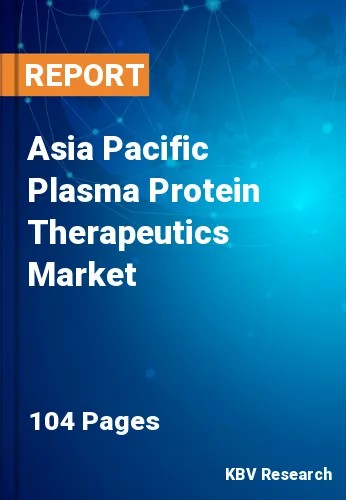The Asia Pacific Plasma Protein Therapeutics Market would witness market growth of 6.6% CAGR during the forecast period (2023-2029).
Patients can live longer, better lives using medications derived from plasma that replace missing or insufficient proteins. People who rely on these treatments usually require injections or infusions throughout their lifetimes. The illnesses and disorders that can be treated using plasma proteins are classified as rare diseases since they only affect a few people. The majority of these illnesses are chronic, inherited illnesses. Some common illnesses treated by plasma protein include hemophilia, idiopathic thrombocytopenic purpura, primary immunodeficiency disorder, etc.
The symptoms of this ailment in its victims include joint bleeding and other problems. Hemophilia A mainly affects men since the faulty gene is on the X chromosome. A woman's male kids will have a 50% risk of having hemophilia A, and her female offspring will have a 50% chance of harboring the faulty gene. There is an influence on every 10,000 people. After undergoing treatment, patients can lead fairly typical lives. A factor IX gene mutation results in hemophilia B, also a blood clotting condition. Though Less frequent than hemophilia A, it is widely known to affect royal families in Russia and Europe.
The Asia Pacific Society for Immunodeficiencies (APSID) was formed in Osaka in 2015 and established in Hong Kong in 2016 to support the growth of PID care and training in the Asia Pacific region. Between 2015 and 2020, APSID held PID Schools ("Schools") for Asia Pacific early-career medical professionals and scientists ("students"). To broaden the Schools' influence within the medical community, some schools were held concurrently with international or national conferences hosted by immunologic or pediatric groups. As a result of all these elements, there is a higher demand for plasma protein therapeutics to treat PID as well as other chronic and rare illnesses, which is boosting the expansion of the market.
The China market dominated the Asia Pacific Plasma Protein Therapeutics Market by Country in 2022, and would continue to be a dominant market till 2029; thereby, achieving a market value of $2,634.4 Million by 2029. The Japan market is estimated to grow a CAGR of 6% during (2023 - 2029). Additionally, The India market would experience a CAGR of 7.3% during (2023 - 2029).
Based on End User, the market is segmented into Hospitals, and Others. Based on Product Type, the market is segmented into Immunoglobulin, Albumin, Plasma derived factor VIII, and Others. Based on Application, the market is segmented into Hemophilia, Idiopathic Thrombocytopenic Purpura, Primary Immunodeficiency Disorder, and Others. Based on countries, the market is segmented into China, Japan, India, South Korea, Singapore, Malaysia, and Rest of Asia Pacific.
Free Valuable Insights: The Worldwide Plasma Protein Therapeutics Market is Projected to reach USD 39.1 Billion by 2029, at a CAGR of 5.5%
The market research report covers the analysis of key stake holders of the market. Key companies profiled in the report include Bayer AG, Abeona Therapeutics, Inc., Takeda Pharmaceutical Company Limited, Grifols, S.A., Baxter International, Inc., Kedrion S.p.A, Octapharma AG, CSL Limited (CSL Behring), Taibang Biological Group Co., Ltd and ADMA Biologics, Inc.
By End User
By Product Type
By Application
By Country
Our team of dedicated experts can provide you with attractive expansion opportunities for your business.

